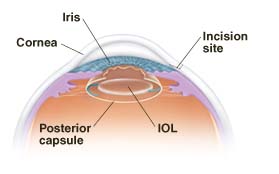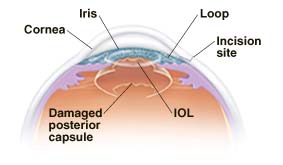Cataract Treatment: Implanting a New Lens (IOL)
Cataract Treatment: Implanting a New Lens (IOL)
A cataract is a clouding of your eye’s lens. Surgery can be done to remove the cloudy lens and replace it with a plastic lens called an IOL (intraocular lens). The IOL can be placed either in front of or behind the colored part of your eye (the iris). Your eye healthcare provider will choose the location that is best. This will depend on the condition of the capsule, the thin membrane that surrounds the lens. It will also depend on the type of IOL you will have. An IOL doesn’t change how your eye looks. But it can help you see better.
Posterior capsule lens
In most cases, an IOL is implanted behind the iris, in the posterior chamber. Flexible loops hold the IOL in place. The posterior capsule also provides support for the IOL.
Anterior chamber lens
If the capsule behind the lens is weak or damaged, your eye healthcare provider will place a special lens in the anterior chamber. This is in front of the iris. Small loops hold the IOL in place.
Scleral-fixated lens
In some cases, the capsule cannot support an IOL, but your surgeon prefers to place the IOL behind the iris rather than in front of it. In these cases, your surgeon may use stitches or place the flexible loops in the sclera (known as the white of the eye) to hold the IOL in place.
Types of IOLs
An IOL doesn’t change how your eye looks. But it can help you see better. Your eye healthcare provider will select a new lens to fit your eye and vision needs. IOLs are made in slightly different shapes. In most cases, the IOL will last for the rest of your life. Talk with your eye healthcare provider about which lenses are right for you. Some things to consider include:
Special materials. IOLs are made of materials that won’t irritate your eye. These include silicone, acrylic, and a type of hard plastic called PMMA.
Foldable lenses. Many IOLs can be folded. This allows them to be inserted through small cuts (incisions) in the cornea or in the white part of your eye.
Multifocal and accommodating lenses. These lenses use advanced technology to improve your range of vision, including seeing up close. For best results, they are put into both eyes.
Updated:
November 11, 2017
Reviewed By:
Fraser, Marianne, MSN, RN,Haupert, Christopher L., MD

